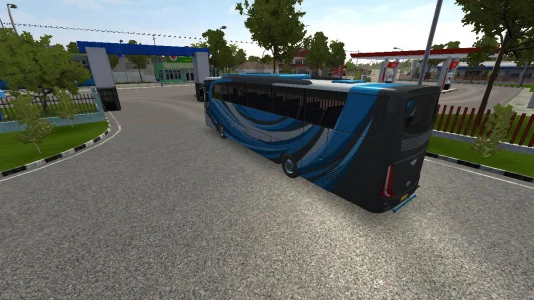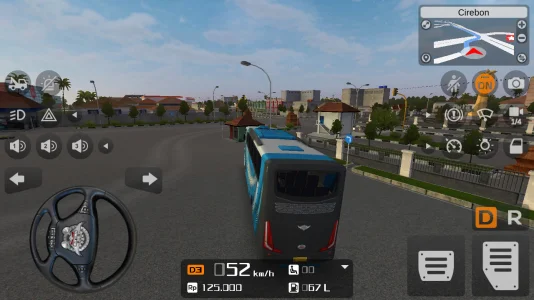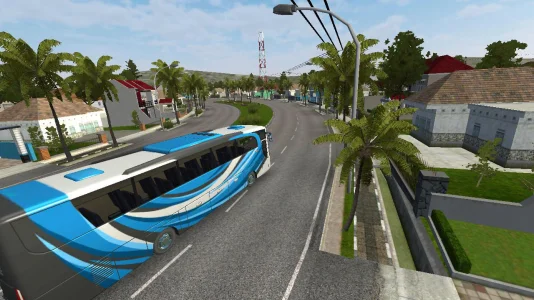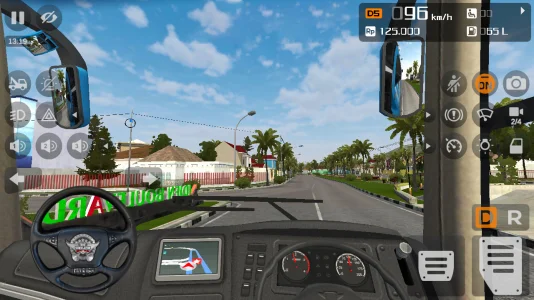Download Bus Simulator Indonesia MOD Unlocked
*Bus Simulator Indonesia* (BUSSID) is a vehicle simulation game developed and published by the Indonesian studio Maleo. The game’s key concept provides an authentic experience of being a bus driver within a detailed representation of Indonesia. In its primary game mode, players complete designated routes between cities to earn in-game currency, which is then used to purchase and manage a fleet of buses for a virtual company. The game is distinguished by its focus on local culture, featuring authentically modeled buses, locations, and unique regional details.
Preview Images




Game Details
An In-Depth Analysis of Bus Simulator Indonesia (BUSSID)
Bus Simulator Indonesia, widely known by its portmanteau BUSSID, is a vehicle simulation game that has established a significant presence within the mobile gaming market. The title was developed and published by Maleo, an Indonesian-based studio. First launched on March 27, 2017, Bus Simulator Indonesia offers players a uniquely authentic experience of operating a bus in Indonesia. The game’s genre is primarily vehicle simulation, but it also incorporates elements of casual, single-player, and offline-capable gameplay. Its core design philosophy revolves around providing a fun and accessible simulation deeply rooted in the geography and culture of Indonesia, a strategy that has garnered it over 100 million downloads on the Google Play Store alone. The game's success is largely attributed to its commitment to hyper-local authenticity. Unlike generic simulators, BUSSID features meticulously modeled Indonesian cities, a fleet of buses replicating those common on the nation's roads, and specific cultural touchstones. A prime example of this is the inclusion of the "Om Telolet Om!" phenomenon, a viral meme where children request bus drivers to honk their distinctive, melodic horns. This integration of a specific cultural moment demonstrates Maleo's profound understanding of its target audience, transforming the game into a shared cultural experience and allowing a small independent team to achieve global reach by first securing a loyal regional demographic.Comprehensive Gameplay Modes
Bus Simulator Indonesia provides a variety of game modes engineered to accommodate diverse playstyles, which ensures a high degree of replayability. These modes allow players to engage with the simulation in a manner that suits their objectives, whether they seek structured progression, creative freedom, or social interaction.Career Mode
Career Mode functions as the game's primary single-player campaign and progression framework. In this mode, players assume the role of a bus driver starting with a basic vehicle. The principal objective involves completing designated routes between cities, transporting passengers to earn in-game currency. This currency is the central resource for advancement, enabling players to refuel, purchase new buses, and ultimately establish their own virtual bus company. This goal-oriented structure provides a clear sense of purpose and achievement, particularly for players who engage with the simulation's economic management aspects without modifications.Free Mode
Free Mode, also known as Practice Mode, offers a sandbox experience without the economic pressures inherent in Career Mode. Players can select any unlocked bus and any available route to drive freely. This environment is ideal for familiarizing oneself with the game’s driving mechanics, testing new vehicle mods, or simply exploring the detailed Indonesian landscapes without the constraints of a schedule.Online Multiplayer Convoy Mode
This mode represents the social core of BUSSID, allowing players to connect with others for group drives, or "convoys." The emphasis here is on shared experience and community interaction rather than competition. Players often use this mode to showcase customized liveries and vehicle mods while cruising together. Access to the multiplayer mode may require a one-time in-app purchase, a decision that can help cultivate a more dedicated online community. The developer has shown commitment to this mode through updates that fix bugs and add features, such as allowing the driver character to exit the vehicle.Tour Mode
As a more recent addition, Tour Mode offers a structured and guided exploration of the game's expansive map. It provides predefined tours along scenic routes and past points of interest, removing the need for manual planning and making it an excellent way for players to discover the breadth of the game's content in a curated fashion.Core Gameplay Mechanics and Controls
The gameplay loop in Bus Simulator Indonesia places the player in direct control of a bus journey, balancing realistic elements with intuitive, mobile-centric mechanics. This "sim-lite" approach prioritizes a casual charm over strict realism, making it welcoming to a broad audience.The Fundamental Gameplay Loop
A typical session in Career Mode follows a distinct sequence. The player accepts a route, navigates to a terminal to board passengers, and then drives to the destination following an in-game GPS. This requires managing speed, adhering to traffic, and contending with a dynamic weather system. Upon successful completion of the route, the player is awarded in-game currency based on performance. While the environments are authentic, the simulation aspects, such as traffic AI and crash physics, are designed to be accessible rather than punishing.Control Schemes and Player Perspective
To cater to different player preferences, BUSSID offers multiple control schemes and camera views. The interface includes on-screen buttons for acceleration, braking, opening doors, and activating lights and wipers. For steering, players can choose between tilt controls, on-screen buttons, or a virtual steering wheel. The experience is further enhanced by the ability to cycle through several camera angles, including a detailed first-person cabin view and various third-person external views.- Authentic Environments: The game world is built around real Indonesian cities and locations.
- Passenger Management: Players are responsible for picking up and dropping off passengers at designated stops.
- Economic Simulation: In Career Mode, earnings are used for fuel, repairs, and fleet expansion.
- Dynamic Weather: The inclusion of conditions like rain adds an extra layer of challenge and immersion.
- Mod Support: A core feature is the robust support for user-created vehicle and map mods.
System and Technical Requirements
Ensuring a stable gameplay experience requires a device that meets the necessary technical specifications. The requirements differ between the native Android version and the officially supported PC version available through Google Play Games.Android Specifications
For mobile devices, the minimum operating system required is Android 7.0 (Nougat) or higher. The total file size for the installation can vary based on device architecture but is typically between 800 MB and 900 MB for the base APK, with additional space needed for user data and mods.PC Specifications (via Google Play Games)
The PC version demands more substantial hardware. The minimum requirements include Windows 10 (version 2004), 10 GB of available space on a Solid State Drive (SSD), a CPU with at least four physical cores, and 8 GB of RAM. The graphics requirement is an IntelⓇ UHD Graphics 630 GPU or a comparable card. The explicit need for an SSD is notable, as its fast data access speeds are crucial for streaming open-world assets without performance issues like stuttering, ensuring a smooth and immersive driving experience.Monetization and Business Model
Bus Simulator Indonesia utilizes a player-friendly monetization strategy that relies primarily on non-obstructive advertising. Maleo's promise of "no obstructive ads while driving" is a key feature that respects player immersion. Ads are instead implemented as rewarded videos, which players can watch voluntarily for in-game bonuses, or as interstitial ads shown during natural gameplay breaks like menu screens. This high-volume, low-friction model has proven effective, with the developer reporting a 50% increase in ad revenue after implementing AdMob's bidding solution. In-app purchases are minimal, with the most prominent example being a potential one-time payment to unlock the multiplayer mode; the game avoids selling in-game currency or other competitive advantages.The Modding Ecosystem and Community
A cornerstone of Bus Simulator Indonesia's long-term success is its active and decentralized modding community. Rather than operating a large, official forum, the community thrives on platforms where user-generated content is created and shared, such as modding websites, YouTube, and specialized forums. This structure is a direct result of the developer empowering players with tools like the official BUSSID Mod Editor. This support allows the community to generate a virtually endless stream of new content, including custom vehicles, liveries, sound packs, and even new maps. This ecosystem grants the game immense replayability and personalization, effectively allowing the player base to crowdsource the game's continued expansion and variety.Final Verdict: A Platform for Creativity
Bus Simulator Indonesia stands out in the mobile simulation genre not for its technical complexity but for its unparalleled cultural authenticity and its function as a creative platform. Its strengths lie in its faithful recreation of the Indonesian driving experience, its player-centric monetization, and, most importantly, its vibrant modding ecosystem. While some hardcore simulation enthusiasts may find its simplified traffic AI and lack of deep damage modeling to be weaknesses, these are effectively mitigated by the game's greatest strength: its community. A limited official vehicle roster becomes irrelevant when players can download hundreds of high-quality models created by fellow fans. Ultimately, Bus Simulator Indonesia's legacy is defined by this symbiotic relationship, proving that a game can become more than the sum of its parts when its players are empowered to be its co-creators.An Analytical Guide to Bus Simulator Indonesia Gameplay
Bus Simulator Indonesia, also known as BUSSID, is a vehicle simulation game developed by Maleo. The game provides players an authentic experience of operating a bus within detailed Indonesian environments. Its design philosophy combines accessible simulation mechanics with a deep commitment to cultural and geographical accuracy, which distinguishes it from other titles in the genre. Player progression is centered around economic management, vehicle acquisition, and skillful navigation through a variety of distinct game modes.
Understanding the Core Gameplay Loop
The Driving and Route Management Cycle
The central gameplay loop in Bus Simulator Indonesia tasks the player with managing a complete bus journey. In Career Mode, a typical session begins when the player accepts a designated route between cities. This action defines the start and end points of the mission. The player then navigates the bus to a terminal, where they manage the boarding process by opening the vehicle’s doors for passengers. Following the in-game GPS and minimap, the player pilots the bus through diverse traffic systems and dynamic weather conditions, such as rain, which necessitates the use of windshield wipers for visibility.
Throughout the journey, the player makes scheduled stops to allow passengers to disembark and new ones to board. Successful completion of the route at the final destination results in a reward of in-game currency. The amount earned is calculated based on factors like distance traveled and overall driving performance. This currency is the primary resource for progression, as it enables the player to refuel the bus, acquire new vehicles for their fleet, and ultimately expand their virtual transport company.
Vehicle Control and Camera Systems
BUSSID offers several control schemes to accommodate different player preferences. Players can select tilt steering, which utilizes the device’s accelerometer for an immersive control method. A second option provides on-screen buttons for precise left and right steering inputs. The third scheme features a virtual steering wheel overlay, which balances immersion with tactile precision. The interface also includes dedicated on-screen controls for acceleration, braking, door operation, lights, and the horn. To enhance situational awareness and the driving experience, players can cycle through multiple camera perspectives. These views include a detailed first-person cabin view, several third-person external angles, and a top-down camera for maneuvering in tight spaces.
A Guide to BUSSID’s Game Modes
Career Mode: Building a Business
Career Mode functions as the game’s primary progression-based campaign. Players start with a basic bus and must complete routes to earn the capital required for expansion. The central objective involves managing finances to refuel vehicles, purchase new buses, and grow a commercial enterprise from the ground up. This mode establishes a clear structure for goal-oriented players who enjoy the challenge of economic simulation and building a company over time.
Free Mode: A Sandbox for Exploration
Free Mode, also called Practice Mode, provides a sandbox environment free from the economic constraints and objectives of the career path. In this mode, players can select any unlocked bus and any available route to drive without limitations. This makes Free Mode an ideal setting for new players to learn driving mechanics, for experienced drivers to test custom vehicle mods, or for any player to explore the game’s authentic Indonesian landscapes at a leisurely pace.
Online Multiplayer Convoy Mode
The multiplayer component of BUSSID is the Online Convoy Mode, which serves as a social hub for the community. This mode allows players to connect with others globally for collaborative group drives. The gameplay emphasis is on shared experience, community interaction, and displaying customized vehicle liveries and mods rather than on competition. Players often form convoys to cruise together and enjoy the scenery as a group, which adds a significant social dimension to the game’s longevity.
Tour Mode: Guided Exploration
Tour Mode is a more structured experience designed for scenic exploration. This mode presents players with predefined routes that highlight points of interest and aesthetically pleasing landscapes across the game’s large map. It allows players to experience curated journeys without the need for manual route planning, offering a streamlined way to discover the full breadth of the game’s environments.
Strategies for Success and Progression
Economic and Career Strategy
Effective progression in Bus Simulator Indonesia’s Career Mode relies on strategic decision-making to maximize income. Players can optimize their financial growth by adopting several key practices.
- Prioritize Long Routes: The financial payment for a completed route is directly proportional to its length. Players should prioritize longer inter-city journeys as they become available to maximize revenue per trip.
- Drive Efficiently: Fuel is a significant and recurring operational cost. Players can conserve this resource by practicing smooth driving techniques, such as avoiding sudden acceleration and hard braking, which also improves passenger satisfaction.
- Explore Community Methods: The player community often discovers and shares optimized strategies for earning in-game currency. Engaging with fan forums and video guides can reveal efficient methods for accelerating financial progression.
Advanced Driving Techniques
Mastering the vehicle controls and understanding the traffic system are crucial for safe and efficient driving. Players can improve their performance by maintaining a safe following distance of approximately two vehicle lengths from AI traffic to prevent collisions. On multi-lane highways, occupying the outer lanes provides a better vantage point for reading upcoming exit signs, which allows more time for safe lane changes. Furthermore, players should adapt their driving to the dynamic weather system, reducing speed during rain to maintain control and compensate for potentially reduced braking effectiveness.
The Role of Modding in Gameplay
Engaging with the modding ecosystem is a primary strategy for enhancing long-term enjoyment and gameplay variety. The game’s design actively supports user-generated content, transforming BUSSID into a creative platform. Mods provide players access to a virtually limitless collection of new vehicles, including different bus models, trucks, and cars. This system allows players to experience new vehicles without the financial grind required in Career Mode. Additionally, custom map mods introduce entirely new road networks and challenging terrains, while sound and traffic packs can dramatically increase the game’s immersion and personalization. The ability to find and install mods is the most effective method for tailoring the gameplay experience to individual preferences and preventing repetition.
